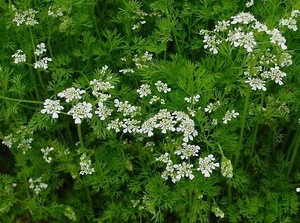

Coriander is also known as cilantro, dhania, Chinese parsley, Mexican parsley.
It is believed to have originated in the Mediterranean area, and in
southwest Europe. It is also the native to southwestern Asia to north
Africa. Coriander is probably one of the first spices used by mankind,
having been known as early as 5000 BC. Sanskrit writings dating from about
1500 BC also spoke of it. The Romans spread it throughout Europe and it
was one of the first spices to arrive in America.
Thought to have been introduced to Britain by the Romans as a meat
preserver, coriander seems to have been cultivated in Greece since at
least the 2nd millennium BC. Coriander comes from Morocco and Romania.
The name coriander derives from Latin coriandrum, which in turn erives
from Greek corys, a bedbug, plus -ander, "resembling", and
refers to the supposed similarity of the scent of the crushed leaves to
the distinctive odour of bedbugs.
It is an annual, soft, hairless, foetid plant growing to 1 to 3 feet
high with erect stems which are slender and branched. It is a bright
green, shining, glabrous plant. The bright, green leaves are fan shaped
and become more feathery towards the top of the plant.
The leaves are variable in shape, broadly lobed at the base of the plant,
and slender and feathery higher on the flowering stems. The lowest leaves
are stalked and pinnate while the segments of the uppermost leaves are
linear and finely divided into very narrow, lacy segments.
The flowers are borne in small, shortly-stalked umbels, white or very
pale pink, five to ten rays, asymmetrical, with the petals pointing away
from the centre of the umbel longer than those pointing to the middle of
the umbel. The seed clusters are very symmetrical and the seeds fall as
soon as ripe.
The fruit is a globular dry schizocarp brown to yellow, 3-5 mm diameter,
consist of two, single-seeded mericarp. They lose their disagreeable scent
on drying and the longer they are kept, the more fragrant they become.
Coriander will not grow well in humid climates. It likes a warm, dry,
light soil. It needs a dry summer and a sunny location.
It is sown in mild, dry weather in April, in shallow drills, and covers
it evenly with the soil. The seeds are slow in germinating. The seeds may
also be sown in March, in heat, for planting out in May. Stems are weak
and the plant may require staking.
The parts used are the fruit, and the leaves.
Coriander fruit contains about 1 per cent of volatile oil, which is the active ingredient. It is pale yellow or colourless, and has the odour of Coriander and a mild aromatic taste. It also contains malic acid, tannin and some fatty matter. They have a lemony citrus flavour when crushed, due to the presence of the terpenes linalool and pinene.